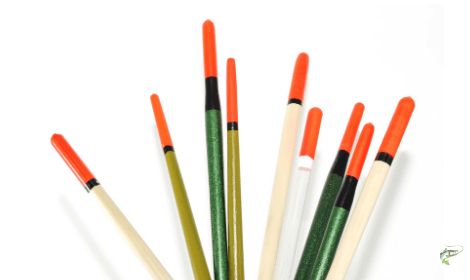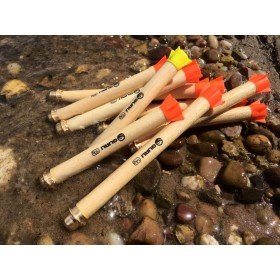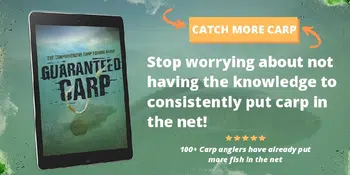
Carp are smart and crafty creatures and are one of the highest regarded fish in the UK and for good reason. These fish grow large, fight fiercely and can outsmart even the most experienced coarse fisherman.
If you are new to angling then I definitely believe carp fishing is the place to start for a guaranteed exciting experience. So if you are here looking for a way to catch these fish then you’re in the right place.
Perhaps the reason for the popularity of carp fishing is that you have to embrace the fact that carp can sometimes be very tricky to catch and particular fishing techniques must be adapted to be able to catch big carp or to increase your carp catch rate, lobbing a hook with some bait on it just won’t do in most cases.
In this article, we will discuss one of the best carp fishing technique, waggler fishing; a must for every novice carp angler. So what is waggler fishing I’m sure you are asking? Well read on and find out for yourself.
Waggler fishing explained
Perhaps the most popular type of fishing in the United Kingdom is float fishing. There is an interesting variety of float designs available in tackle stores which can make things confusing for beginners. Float fishing for carp is a simple, effective and an enjoyable way to catch carp.
Although you’ll find a large variety of floats the waggler is the most common for carp these days. They are simple to set up, allow for steady and tangle-free presentation that works with most bait types. So in simple terms, wagglers are floats attached from the bottom end.
This makes them simple to rig since you can just fix them in on your main line with a few split shot above and below the waggler. This kind of float provides good stability, where the line can sink naturally into the water, beating surface tow of the water.
Fishing with a waggler rig is not only common for carp but many anglers use this rig to catch many other coarse species. The waggler is cast in an overhead technique, with the line between the waggler and the rod sunk below the surface of the water.
This removes any drag on the float and allows it to keep its position. Immediately the float will settle in the water, ready for you to watch that float for that much anticipated bite. When there is a bite and the float is pulled under, strike into the fish and more often than not you will find yourself hooked up.
Like most carp fishing you will want to provide some other bait to attract the carp to your hook bait. Once your float has settled in the water you can use this as a target for throwing in pellets boilies, maggots or really anything else you please to give yourself the best chance of attracting carp to your swim. Make sure and not overfeed though.
Choosing the right waggler
Just like all kinds of fishing methods, you want to drop the bait where the fish are and keep them there. With waggler fishing, there are many conditions that can make this difficult, like:
If you are looking to fish a far swim, you may have difficulty casting to it as waggler floats are rather light, when I’m fishing the waggler’ll usually fish the margins but this doesn’t need to be the case.
If the wind is strong, you may not be able to keep the float above your loose feed.
If you are fishing long range, try casting to where you want to fish. Then, put the line in the line clip of your reel. This will allow you to cast to the same place each time, making sure that the hook bait is in the feeding space. Don’t forget to feather the line when casting to help avoid dreaded tangles.
Attaching the bulk of the split shots around its base can help make the rig work like a dart as it flies through the air. This will make it possible to cast it further with greater accuracy.
Wagglers come in different sizes and shapes, but each is made for certain styles of fishing. Try to be sure you are using the right waggler for the type of fishing you are aiming for.
Splasher
Splasher wagglers are usually used when targeting carp in the upper sections of the water. The large splash caused by the large head on the float should attract carp to the area and hopefully your sinking hook bait.
Pellet
Pellet wagglers are fairly new to the scene but are definitely becoming very popular. They are most commonly used for fishing shallow depths and the weight of the thick body helps to hook the carp as it tries to swim away with your hook bait.
Fishing the pellet waggler is one of my favourites and is a great way to produce large amounts of commercial carp throughout the warmer months. It is basically a floating tactic that is based on heavy feeding to bring the fish into your swim and feeding below the surface where they struggle for the loose feed. The ideal bait for this type of fishing is a sinking pellet between about four and ten mm.
Although the rig is not difficult to create, it is the feeding that will make or break a session when fishing the pellet waggler. The tip is to feed a little and regularly, which means that you feed a few pellets per minute. This will make a lot of tapping noise on the surface that will help attract carp, but it will also create a constant stream of bait that falls into the water.
Once the carp find this bait that falls, it will begin to intercept it, eventually swimming up to grab the feed before the other hungry carp swim in. They will eventually rise so high that you will notice swirls on the surface as soon as a new pellet.
Insert

Insert wagglers have very fine tips that are ideal for fishing on days when there is very little wind. The insert waggler gives great bite indication for shy feeding fish.
Clear Wagglers
Clear wagglers are great for fishing clear waters on bright days. Clear wagglers cast minimum shadow on the water so you are much less likely to spook any fish in the area giving you are higher chance of catching.
Setting up the rig
Setting up a waggler rig is easy. If you want to get the best results from the rig you are using then follow the simple and easy steps to help you tie one of the best waggler rigs. The best way to explain how to tie waggler fishing rigs is to show you. Make sure and watch these videos below and you’ll be setting up waggler rigs in no time.

As you can see setting up a waggler rig is extremely easy but you are not done yet. If you are fishing with a float that does not have weight at the bottom your waggler will not sit upright in the water and will simply float side ways. This is no good.
To sort this you’ll need to get yourself some split shot weights. All wagglers should come with letters and numbers written on them that will tell you how many split shots and what weight are needed to set the float up correctly. If the float is rated “3BB” it will need 3 BB split shots so the float will sit in the water correctly.
A good rule of thumb is to attach around two-thirds of the required weight at the top and bottom of the float. Make sure and not clip the split shots on too tightly or this could damage your line which could result in breakage and lose of fish.
You’ll now want to attach the remainder of the weight required down the line towards the hook. Where and how split shots you attach will depend on how fast you want the line and hook bait to sink. If you want to sink the line quickly try a cluster of size 4 split shots about a foot from the hook bait.
If you are looking for slow sinking line attach a few size 6 spit shots evenly spaced down the line.
A really important factor is to make sure you attach a size 10 split shot two to three inches from your hook. This will ensure any bites are indicated straight away to avoid deep hooked or missed fish.
Waggler fishing tips
To keep the waggler in place, you can use three small line stops. With that, you can cut and change the depth without fear of damaging the line.
The fishers who have the most success on Waggler are those who work hard. It’s definitely not a method for a lazy fisherman. You need to be continuously feeding and casting so your hook bait falls through the water with your feed. Try casting every 30-60 seconds.
Always make use of a floating adapter: when fishing pellet waggler, this will not only lock the float in place but it also lets you change the depth without damaging the line; it also allows you to swap floats easily if the conditions change.
Choose the right size of pellets: The important thing about Waggler fishing is feeding and so, feeding the right size is very important. When aiming at small carp, you can use 6mm pellet, but when targeting the big carp, 8mm pellets may be the ideal choice.
One thing you should consider is that the smaller pallets are difficult to feed at distance, so if you want to fish at distance and the conditions are bad you can feed bigger pellets.
Anglers tend to dampen their pellets as soon as they reach the water. Don’t do this! Dry pellets taken straight out of the bag are best when waggler fishing. These dry pellets sink far slower and can is really important when fishing shallower waters.
Using a wide gaped hook can help in hooking more fish. Wide gaped hooks make it easier for the point to penetrate the carps mouth.
Finding the depth of water is also something you should always be doing. When fishing the waggler start with your hook at a shallow depth of around 2ft. If you see no bites in ten minutes adjust your float so your line sinks around a foot deeper until you start to get some bites
Try It!
Fishing the waggler can be an extremely fun and rewarding experience especially during the summer months. Waggler fishing can become confusing for beginners as there is so much information about different waggler rigs out there today.
That being said it doesn’t need to be difficult. If you strip it right down to the basics and follow the simple steps above you can see yourself hooked into some nice fish with your waggler rig. Make sure and give it a go and let me know how you get on in the comments below.




